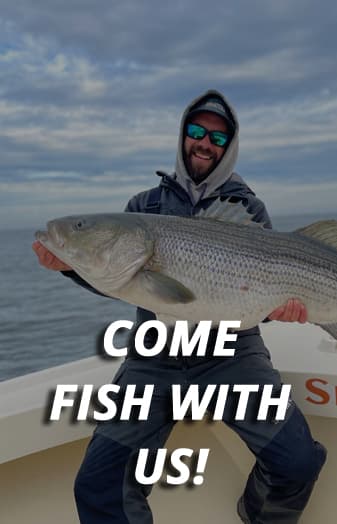Cobia Basics
Cobia are a highly migratory inshore species sought after by anglers from the Mid-Atlantic states to the Gulf of Mexico. These fish have the ability to become a very large powerful adversary and their willingness to bite makes them a game fish that you’ll never forget. Before setting out on your next nearshore adventure lets be sure your tackle is up to the challenge.
Rods & Reels
Landing a giant cobia on light tackle can be as exciting as it can be nerve wrecking for anglers. Selecting a rod that has enough back bone and power to pull a cobia off a wreck, piling, or buoy chain is very important. When casting jigs or live bait I prefer a 7’ to 7’6” spinning rod. A heavy, fast action rod blank will allow you to cast a 2 or 3 oz jig. For myself, the St. Croix Inshore Mojo Series rods have been tried and true, mid priced rod that has been hard to beat on my boat. Pairing a 7’ heavy action rod with a sturdy spinning reel loaded with an ample amount of 40-50 braided line ,such as Power Pro is the ticket. Shimano’s new Saragosa 10000 spinning reel has been a great addition on the boat and has enough drag and line capacity to stop the biggest of inshore species. When dropping baits and jigs to the bottom, vertical jigging, trolling or chunking bait a casting rod with a similar action and length coupled with an appropriate size baitcaster or small conventional reel is a great addition to your arsenal. Baitcasters, such as a Shimano Calcutta 400, will allow for better line control for these techniques and they have the stopping power to hold fish off of wrecks, pilings and other obstacles.
Knots, Jigs, and Terminal tackle
After selecting your rods and reels for the most effective techniques for your area, it is time to rig up. Your knots are now the most important thing connecting you to that inshore fish of a lifetime. There are a variety of knots to connect braid to monofilament which is always a topic of great debate. When targeting large powerful fish, I like to double up my braided line and tie a Bimini twist or a spider hitch for shock absorption, not just for strikes but for launching heavy jigs and lures. From the double line braided end, I will attach a 24”-30” 60lb leader with an Albright knot. This allows for smooth passing of the knot through the guides then casting. Braided fishing line has revolutionized light tackle fishing, but with zero stretch I find that doubling up the line drastically reduces break offs, especially when launching heavy jig, plugs or weight. A monofilament or fluorocarbon leader is important for leadering and wrangling the fish. Braided line under tension is extremely sharp. Severe line cuts or worse is possible if you leader a fish and grab the braid. Always use caution to avoid accidents with braid. When a fish gets close I use a pair of gloves such as the AFTCO Release gloves.
There are lots of anglers, charter captains, and guides whom love other knots such as the FG, double uni, and Bob Sand’s knot when connecting braid to leader. I suggest that you fish a knot you are comfortable with, can tie quickly on the water, and have confidence in it’s performance.
Casting jigs to these fish is very exciting for the light tackle anglers. Artificial lures such as bucktails, plastics, stickbaits all put fish in the boat year after year. I prefer single hook baits because its easier on the angler and fish alike. A 1 to 3 oz bucktail or jig head tipped with a Hogy soft plastic is my go to bait. Recently Hogy Lure Company came out with a Pro Tail Eel tail and paddle tail baits that has changed the game. Great action, colors, weights, and durability for multiple fish per bait, these plastics have also become must have in the cobia tackle box. Many people will encounter tooth critters such as bluefish and mackerels in the same areas where cobia are hanging out. In these circumstances a standard bucktail hair jig or stickbaits with single hook replacements are great choices.
When live baiting or chunking a heavy-duty circle hook is hard to beat. Circle hooks are great on the fish and when fished properly a very high hook up ratio. The Owner SSW circle hook in a 4/0 is a great hook for many live bait applications. Cobia, being an opportunistic feeder, will eat most local baitfish from your area if presented live and occasionally even presented dead. When bottom fishing I prefer a fishfinder rig that allows the bait to slide freely away from the weight without the fish feeling any resistance. When rigging I like to have a 3’ leader from weight to hook with a quality barrel swivel stopping the weight and connecting the braid to the leader.
Safe Fish Handling and CPR
Cobia are strong, power fish and they are known for not being very corporative when they are boat side. In previous year it was the norm to gaff these fish if they were intended to be harvested. Now it seems many conservation minded anglers have switched to netting these fish for the easier fish handling even if they are going to harvest the fish. Large basket nets with heavy-duty collapsible handles are the way to go. A 60lb Boga Grip or similar fish handling tool can be helpful for a quick photo before releasing a trophy cobia (CPR/ catch-photo-release). It’s a good idea to have your camera or phone ready for a picture to minimize the fish’s time out of the water.
With increased fishing pressure in recent years, catch and releasing cobia regardless of your state’s or federal bag limits is a great way to insure the future of your fishery. Large females that lay millions of eggs are undeniably more valuable to the fishery than as table fair. Cobia are a great eating fish, grow rapidly, and healthy choice of fish for the table, but a common sense approach to harvesting these fish should be an important consideration for anglers.



